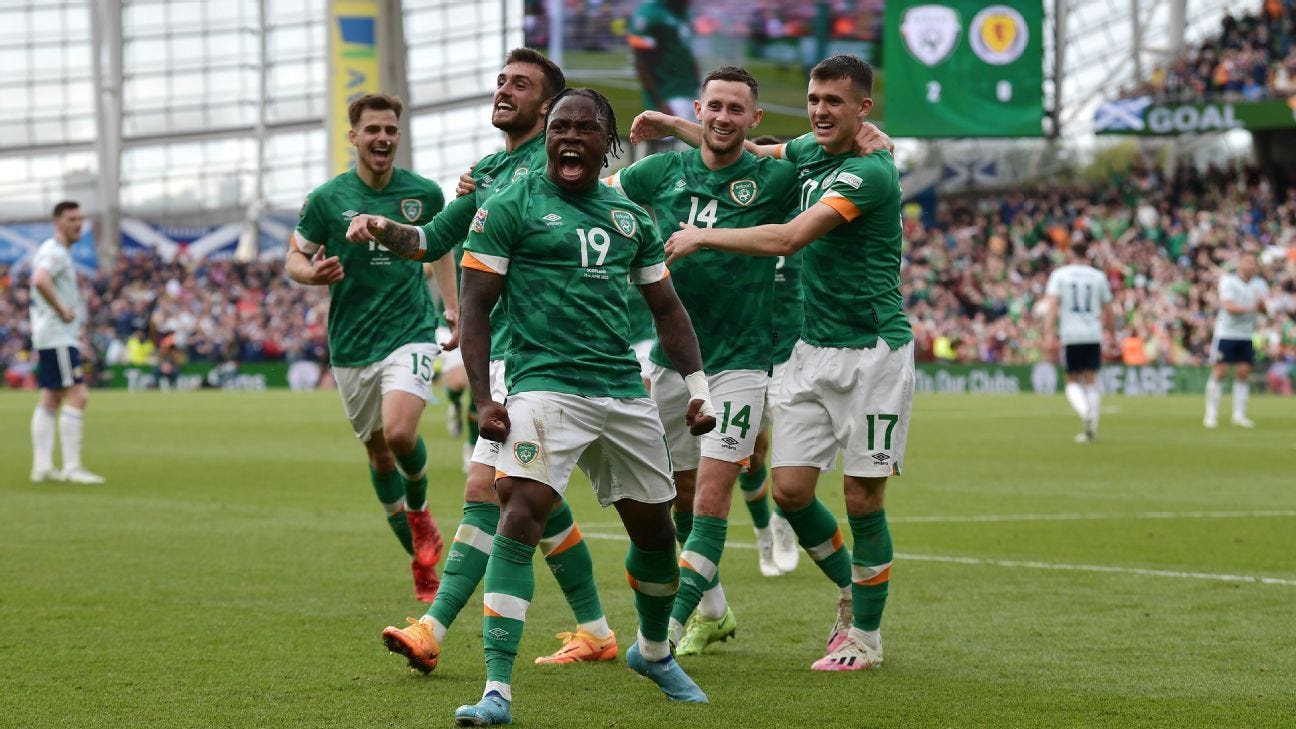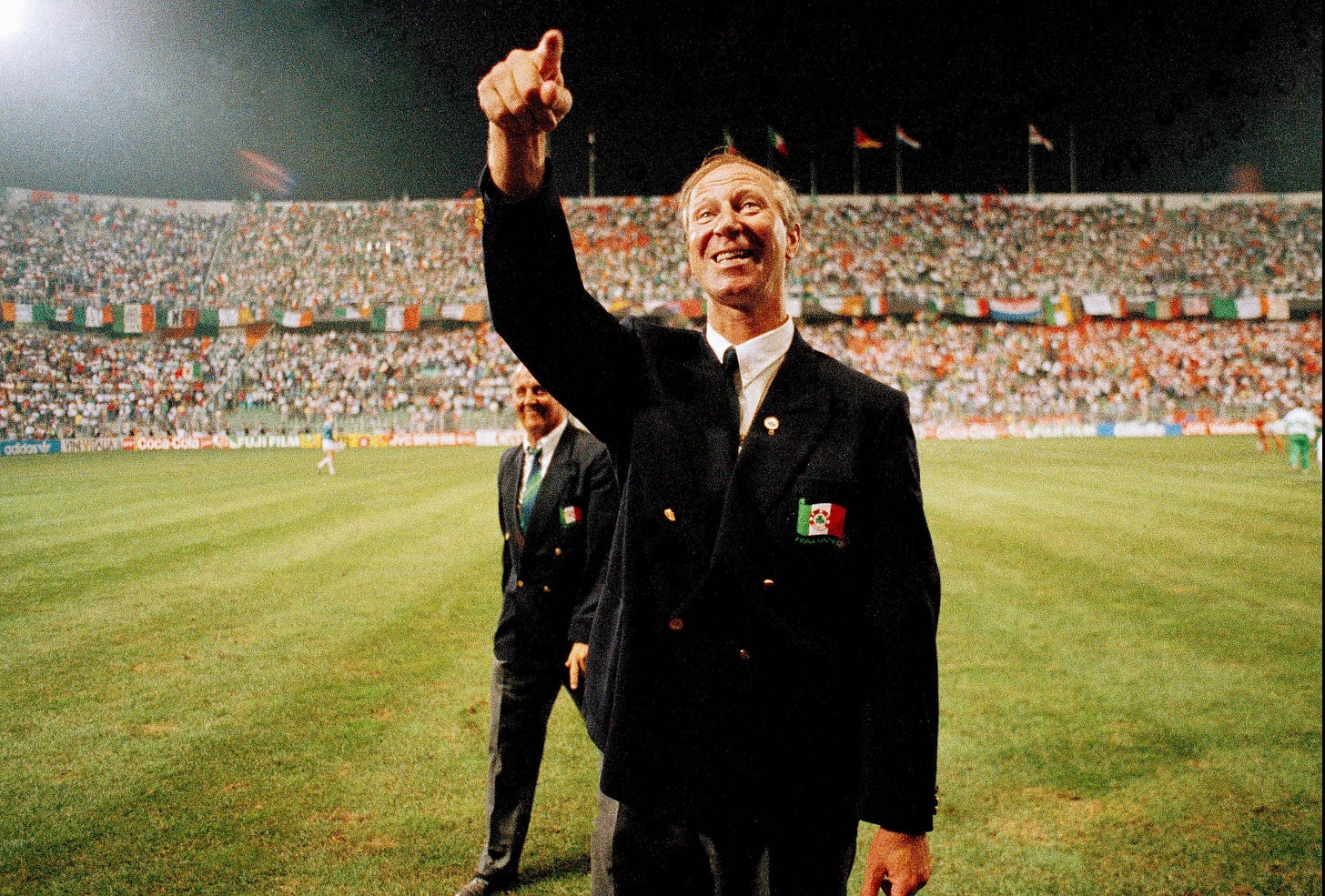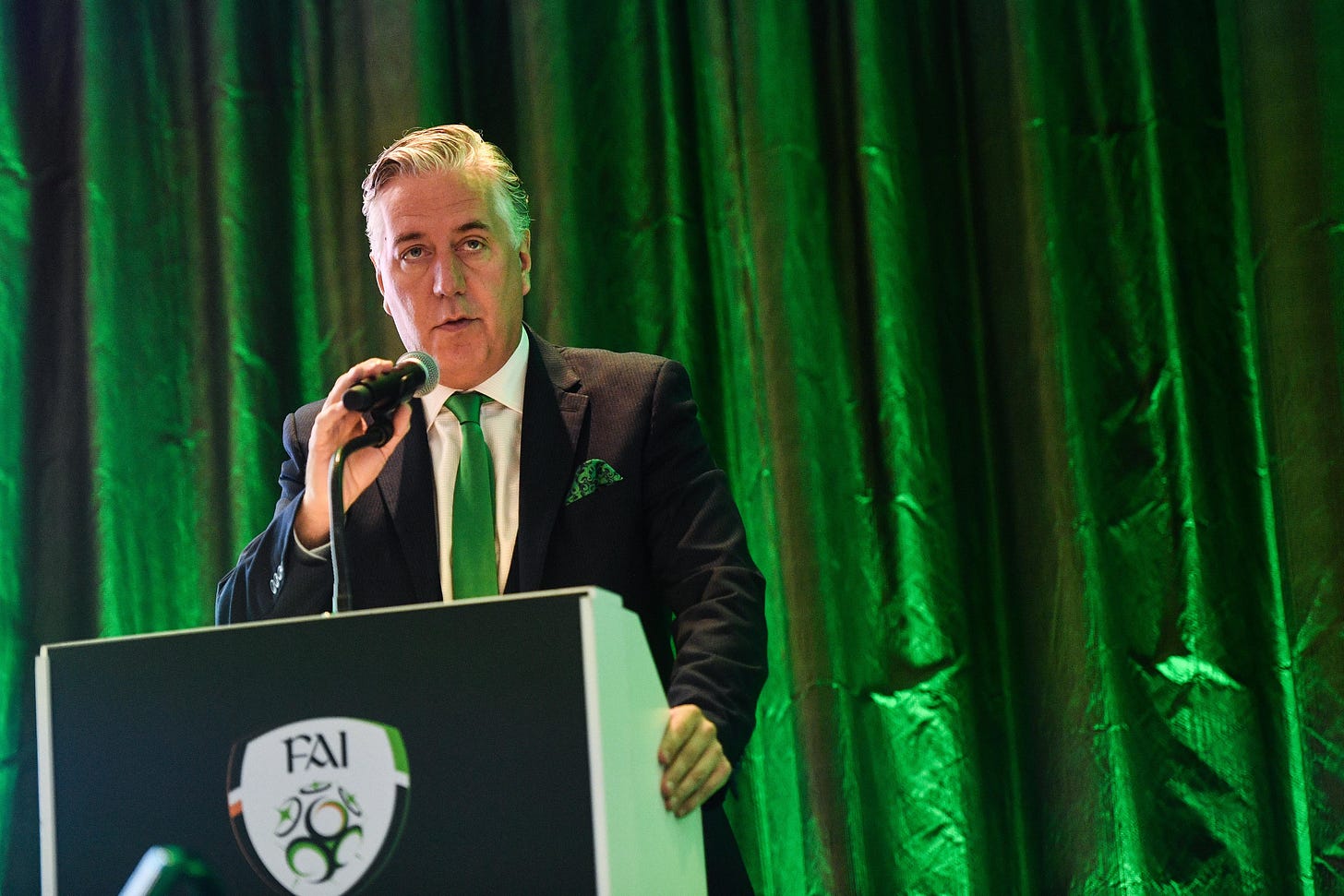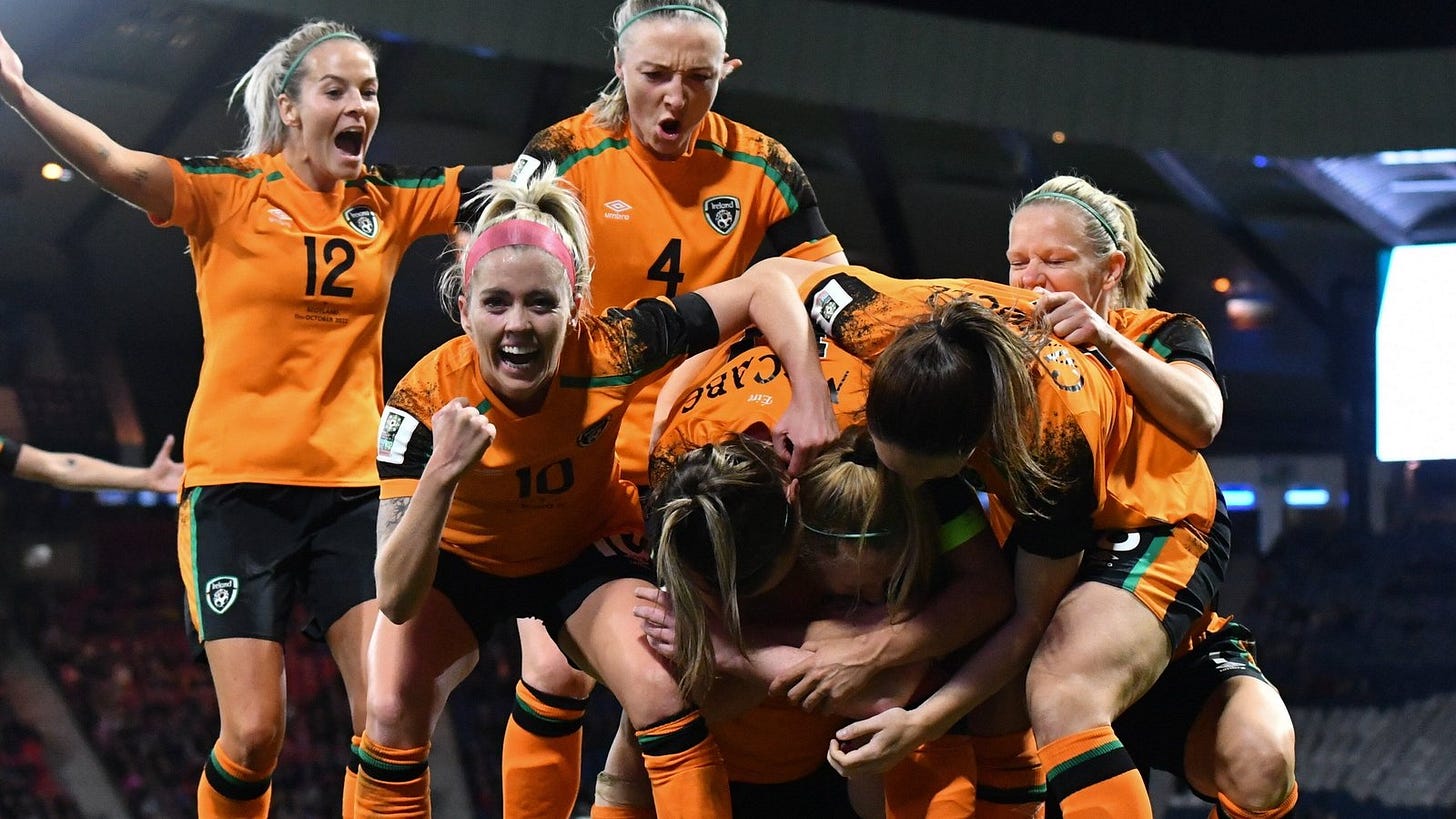A terrible beauty may be reborn
Irish football is back. The Men, the Women, our Youths, our Clubs, they've all been hugely successful. All in spite of every hurdle that's been put in front of them.
On November 11th, 2021, The Athletic’s Daniel Taylor and Michael Walker wrote a piece titled “The fall of the Republic of Ireland and the reason there’s now hope again”.
Irish footballers were once regarded as some of the best in the world as they had a significant presence at the top clubs in English football. In the last two decades, as Roy and Robbie retired and Duff and Dunne’s talent dwindled, it’s been hard to pick out one International player that could be classed as a surefire star.
It’s been a rough period for football in Ireland, to say the least, but this moment in history should not be surprising. It hasn’t been to the vast majority of grassroots fans. Most of us have had an over-inflated sense of belief in the Irish national football team. We’ve gone into each tournament cycle thinking that Ireland should be making it to every single major tournament that comes around. The fact of the matter is Irish football has over performed for decades, yet in that time we’ve done nothing to evolve and put ourselves in a position where we can feel worthy of the performances we put in. Our lack of Evolution has been down to two main faults.
Stubbornness and Greed.
Route 1: Stubbornness
The Jack Charlton teams of the 1990s were able to consistently make it to International competitions off the back of a, quite frankly, boring style of play, while also making major use of Irish familial links that English players had. This style and method of management suited the time period though.
Charlton worked off the belief that international defenders were “never properly tested”, and he realised that there were vast areas of the pitch behind the two back lines that were rarely used. The majority of play happened between both defences.
“I’d seen the World Cup in Mexico, and it was like peas and a pod,” Charlton said on, of all places, Desert Island Discs. “Everybody played the same way, through a playmaker in midfield, and unless the playmaker was in a good position to go at the back four, nobody would commit themselves forward.” So, Ireland would seek to commit themselves forward.
Charlton would seek to fill those rarely-used areas behind the defences. This is what was genuinely different and innovative about Ireland. It wasn’t just long balls and tackling high up the pitch, as so many sides had done. Those tactics were just the vehicles to do something that nobody else in the international game was doing. That should be evident in the way his side generally aimed for the corners of the pitch rather than a big man up front, as so many route-one sides did.
Ireland filled the open space behind the defences, and would then seek to maximise it by bombarding balls into the box from there. This can especially be seen in the qualifiers for the Italia 90 World Cup, and it is little wonder that both goals in the tournament itself came from forced opposition errors.
This style of play was the making of the Irish national team on the world stage, but it has also been the breaking of us since our period of joy ended at the last World Cup we ventured to in 2002. Since then, Ireland has restricted itself, believing that we had found the perfect style of play. Lumping it up to the big lad or in behind to the pacy lad has brought us brilliant moments, no doubt (Two goals vs Germany spring to mind, one at the World Cup in 2002 and one vs the then World Champions in Dublin in 2015), but the lack of evolution we’ve seen over the past two decades has seen an Irish team once filled with notable names become a shell of its former self. Route One has little place in this game anymore.
Even when we’ve had notable names in the modern game, players like Robbie Keane, Damien Duff, Shay Given, John O’Shea, Richard Dunne, we still insisted on bringing in managers to limit them from using their abilities. Even the players got sick of it. They were better than that. Current Irish coach Keith Andrews has detailed how in the return leg of Ireland’s notorious playoff vs France to make it to the World Cup in 2010, the Irish players grouped together and decided to completely ignore how then manager Giovanni Trappatoni told them to play on the night.
It’s been noted in the past how technically brilliant players like Wes (Wessi) Hoolahan were ignored by Trappatoni and Martin O’Neill because they wouldn’t buy into their philosophy. These ideas have, in part, killed Ireland’s growth in Football.
Ireland has failed in implementing a fresh new way of playing football in kids from young ages. Almost every other country is ahead of us in terms of footballing academies and producing talent that has the potential to make it big. Children from the ages of five and upwards learned to pass the ball the same way that the national team had played. Hoofball.
The blame all falls to the FAI who has been in charge of overseeing this change as well as providing the best resources and facilities to attain this, which they have not. The failings in our development methods have set Irish football back almost 20 years which we are truly paying for now.
Stephen Kenny may not be Ireland’s man long-term as head coach, but the style he has brought to Irish football should be here to stay. Ireland need to be creating better quality footballers. This way of playing is deeply ingrained in the Irish identity.
Irish fans have seen how our national games of Gaelic Football and Hurling have evolved over that time period. While it used to be about kick passing long balls up to the big lad, hoping he’d take it down and score, or hoping the other big lad up against him was strong enough in the air, we’ve seen the game change. Now it’s all about the High-Press, man-marking, movement in attack, learning the ability to break down low-blocks.
Croatia has a smaller population, but their links to Handball have allowed them to create incredible technical footballers. How are we not creating incredible technically and physically strong footballers who can run for days?
We have the ability, but this moves me on to the next, and most important point. While we haven’t adapted on the pitch, our deficiencies off it have been 55 million times worse.
2. Greed
The decline of our national league and the lack of a coaching structure in Ireland thanks to the complete greed and ineptitude of our football association and the successive Irish governments that have facilitated them meant this dark period was always coming.
For the past 70 years, Ireland’s dominant model of football development has been exporting players in their mid-teens to English clubs. This worked quite well for decades, as Irish players have populated almost every English team in the Football League at some stage. From the end of the second world war to 1970, English clubs signed 123 Irish players, and only more Scottish players joined these teams during this period. Brilliant footballers such as John Giles, Liam Whelan, David O’Leary and Liam Brady made the journey across the water at a young age and became some of the best in Europe.
Between 1946 and 1955, 46 of the 85 Irish players who left for England joined teams in the English top flight. This indicates that the quality of Irish players who left was high, but also shows that the size of the talent pool available to English clubs was small in comparison to later decades. As this talent pool widened and eventually became globalised, and the League of Ireland declined, fewer and fewer Irish players were transferred to English clubs.
Irish football development essentially becoming subsumed with that of its more powerful neighbour during this period. This coincided with the talent pool becoming globalised, and thus the final step to the first team became more and more difficult to make for Irish players in England. Between 1996 and 2005, 148 Irish footballers migrated to England, but just 40 made an appearance in the Premier League. Between 2006 and 2010, just eight of the 52 Irish footballers that signed for English clubs as teenagers made a first-team appearance in the top-flight.
With such a low success rate, the focus on exporting young players cannot be considered successful, yet it continues to be the primary aim of Irish youth football, despite warning signs stretching back decades. In short, Irish football is failing the overwhelming majority of these players and we’re letting talent slip through the cracks, something a small country just cannot let happen.
The problem in our national league lies mostly off the pitch. Clubs in Ireland are in dire need of investment to help fund the likes of stadiums and better facilities to influence the overall appeal of Irish football. The appeal of the league has declined in recent years due to no progress being made. The same facilities and the same way of playing football have barely evolved when compared to other leagues. Attendances have been one of the critical standouts from this as clubs have seen figures go from the thousands weekly to the hundreds in just a couple of years.
The FAI’s lack of involvement in the league played a major part in this decline. Every other league gets the backing that they need each season to support them year long with whatever they need. Clubs in Ireland rely heavily on getting into Europe to make any real money as the prize money for winning the league itself isn’t worth much. Public funding is another key factor that many clubs rely on, which really shouldn’t be happening for the country’s national league. In 2016, the FAI dished out just €100,000 amongst the 20 clubs involved, working out at €5,000 for each club. This was to help them with their five-year strategic plan. It is crazy to think that the governing body over Irish football thought that this was enough to help clubs over five years.
To put this into perspective, former disgraced FAI CEO John Delaney at the time was earning over €400,000 annually. To even further put this in perspective, as part of our national betting levy, horse-racing and greyhound racing receives government funding of around €55 million per year.
In 2019, we saw the true colours of the FAI and Delaney come out when they were thrown into turmoil. It was revealed that the organisation had net liabilities of €55 million (that figure has risen to €63 million in the years since). Currently they are only being kept afloat by financial support from UEFA, along with sponsorship deals for our national stadium (sponsored by insurance company Aviva) and our jersey (being made by Castore, the highest bidder in a recent new contract signing, and also in recent years being sponsored by 3, the telecommunications company, and next rumoured to be the media company Sky, making us one of the only national teams on the planet with a jersey sponsor).
There is so much uncertainty as to where this debt incurred was actually spent, with little evidence to support it. At the time of his firing, John Delaney received a severance package totalling €462,000, with additional payments added. This is a perfect example of how badly the body has used the funds over football in Ireland. More money has gone elsewhere into unknown transactions than into the league itself.
There is a hugely important role played by League of Ireland clubs in their communities, and if there is no support financially, then it was always going to have disastrous effects.
The support for grassroots football has been just as underfunded which we have seen due to a lack of young talent coming through in recent years. The FAI receives €2.9 million in state funding annually to spread amongst grassroots football in the country. This was suspended, but the government would eventually decide channel €2 million directly into grassroots football due to a lack of trust in the FAI.
Clubs and leagues in Ireland need this to function as soccer is the most played sport in Ireland, receiving almost half a million children each year taking part. Sadly, it isn’t just the funding that is affecting underage football and the development of players, it’s also the quality of coaching, with Ireland ranking below countries like Luxembourg in the quality of coaching and the availability of high-quality coaches. Much like everything else, the FAI have turned trying to get involved in coaching into a cash grab, driving many young coaches away from the game.
3. The Future
In spite of everything, there is hope on the horizon for Irish football.
A new generation of Irish footballers is coming through, unrestricted by playing style, colour, creed, or gender.
Ireland is an increasingly diverse society, and while before the only non-white players that Ireland knew of were the great Paul McGrath, and the (very unfortunately) rarely capped Clinton Morrison and Steven Reid, all three dispersed across different generations, now our sports teams are starting to reflect that diversity. Darren Randolph and Cyrus Christie kicked it off. Now the teenagers I teach every day look up to Irishmen like Chiedozie Ogbene, Michael Obafemi, Gavin Bazunu, Adam Idah and Andrew Omobamidele.
And that’s just the men, let’s not forget the incredible Irish Women’s team, making their way to the World Cup in Australia this year, led by the incredible Vera Pauw. We now get to see our young girls look up to their heroes, like Katie McCabe, Courtney Brosnan, Niamh Fahey, Amber Barrett and Áine O’Gorman as emphasised this Christmas with a beautiful moment on our most popular national talk show.
We’re seeing Stars arrive on the scene for Ireland again. Gavin Bazunu and Caoimhin Kelleher are making major names for themselves in goals. Nathan Collins is one of the best young Centre Backs in the world. Josh Cullen is running things for Burnley in Midfield. Katie McCabe is the Queen of North London with nobody looking like they can usurp her. Evan Ferguson is just barely starting out but already looks like he’s going to be Ireland’s next big name. They’ll be selling hats and scarves with all those names plastered across them soon.
A Golden Generation is approaching. Young players across the age groups are making names for themselves. Joe Hodge starting games for Wolves and Tom Cannon smashing home goals for Preston in our U21s. The U17 team just qualified top of a group containing Italy to make it to the European Championships.
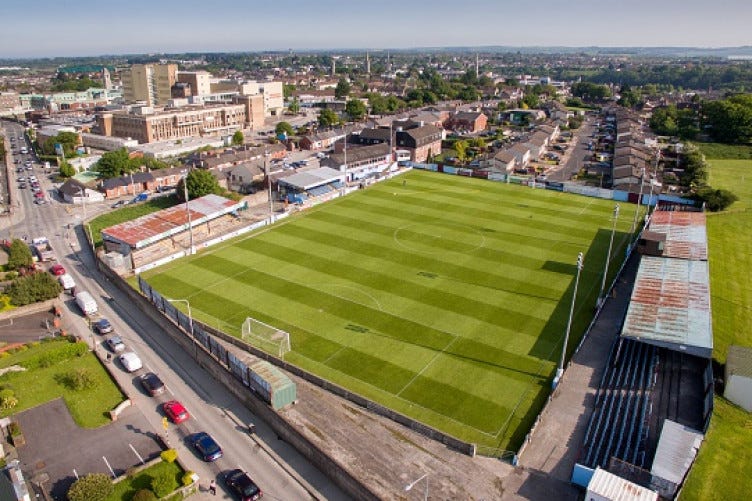
And it’s not just the National Team that things are looking up for. Irish Premier Division football has never looked better. Modern managers coming through are following the lead of National Team coach Stephen Kenny in playing positive, attacking, technical football, and it’s paying off. In recent years, Dundalk have made it into the Europa League, playing in the same group as Arsenal in 2020. Shamrock Rovers made the group stage of the Europa Conference League last season, earning draws against Gent and Djurgårdens.
Teams are selling out grounds across the country, with average attendances of 2,000-3,000 people in truly awful grounds, further emphasising our desperate, immediate need for investment in new facilities. There is an appetite for growth in Irish football. Fans want to go watch their local teams, they want to see those teams play positive football, and they know that if they do, they can challenge some of the better teams in Europe. No longer do we want to be the plucky underdog, now we want to be the ones to beat.
All of this has been done DESPITE under-investment, greed and corruption from our football association and our government. Everything has been worked towards from the grassroots level, in direct contention with those who hold the power over our sport and our nation.
With the first games of the European Qualifying campaign coming up in the approaching international break, Ireland are back on the rise. Don’t underrate us. Do so at your own peril. These players will go out against any opposition, and we know we can beat you at your own game. The Women’s team is going out to win the World Cup. The youngsters are looking to win the Euros and set themselves on an amazing career path. The Men are going out there to top their qualification group. And our clubs are going to make life a living hell for you in the Champions League, Europa League, and Conference League Qualifiers and Group Stages.
Australia? France? The Netherlands? Watch out.


